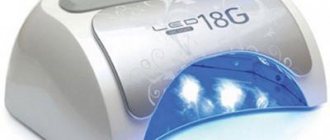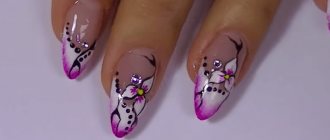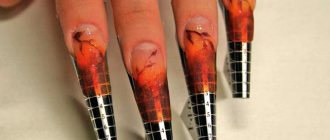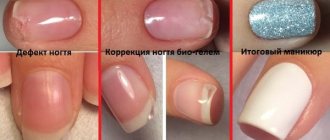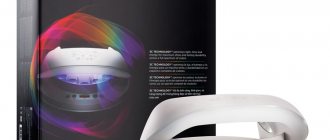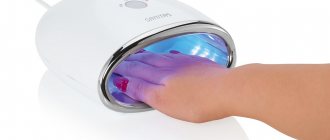Ice (LED) lamps are small devices that use LED light bulbs to dry LED gels, some biogels, colored gels (not all) or any gel nail polish.
Each lamp is large enough to fit the nails of one hand.
And some models can accommodate two hands at once.
In this case, you do not need to leave your fingers under the lamp for a long time.
Ice lamps for nail extensions are considered a safe method compared to UVA/UVB curing because there is no risk of skin cancer from LED bulbs. Some gel manufacturers even create their own nail extension lamps.
LED nail dryers have many advantages over UV models.
- Firstly, they work much faster - it takes from 10 to 90 seconds to polymerize one layer of gel polish, as opposed to 1-3 minutes in a UV lamp for nail extensions.
- They are durable (LED lifespan is 50 thousand hours). The service life of one bulb in a UV lamp is from 1500 to 2000 hours.
- Ice lamps for nail extensions are more effective because they use a very small amount of energy.
- They don't get hot like UV lamps, so there's no risk of burning your hands.
- The best benefit is that the ultraviolet rays emitted by ice lamps are a tiny fraction of what UV lamps emit.
- LED lamps are environmentally friendly - they do not release any toxic chemicals into the environment when disposed of.
Disadvantages of ice lamps for nail extensions:
- LED lamps tend to be slightly more expensive than their UV counterparts.
- No matter how good the lamp is, eventually the time will come when you will have to replace it entirely, and not just buy a new light bulb as is the case with a UV lamp.
- Some gels do not harden in an ice lamp. It's all about the length of the emitted waves. Thus, in lamps with UV rays, fluorescent light is emitted in a wide range, and the gel hardens in any case. But LED devices do not provide enough light, so not every gel has enough light for polymerization.
We recommend: Is it harmful to extend nails with gel?
Why do we need these lamps?
Well, the courses on nail coating have been completed, and a certificate as a manicurist and pedicurist has been received. If the training was carried out using the teacher’s equipment, then you may find yourself at a crossroads - what power is the lamp needed, what manufacturer, will it be used only at home or is it worth starting to make money in this industry? There are many questions, but the main one is: which one is better to choose for the starting step?
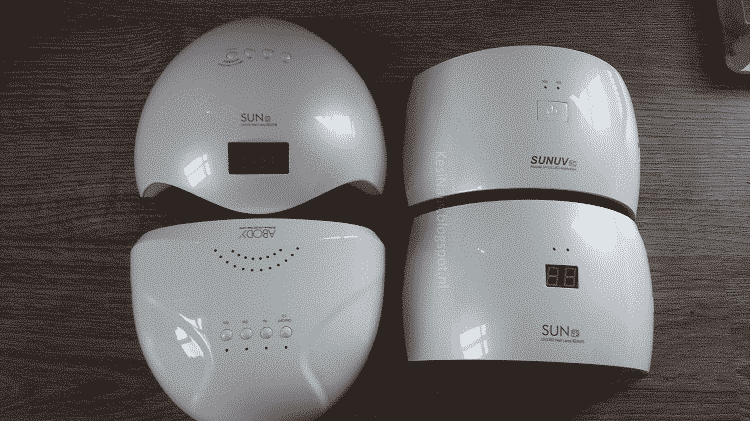
All existing lamps have one thing in common - they all emit ultraviolet radiation. Only the method of its emission, wavelength and spectrum of action are different.
To create the correct nail shape, nail industry masters use extension gels. Less often - acrylic. In order for the material to harden and become a “nail”, you need a lamp with ultraviolet radiation of the desired wavelength. Such devices include UV lamps with fluorescent lamps.
Gel polish coating also requires drying. Gels that have been developed recently harden under LED lamps. Polymerization can last for different times, and it depends on the power of the device.
New to the industry are CCFL devices. They are able to emit ultraviolet light in a different way - using cold cathodes (tubes filled with gas).
Universal devices can also be found in the professional accessories market. They are combined devices (hybrids). They operate on the basis of both LEDs and fluorescent light sources.
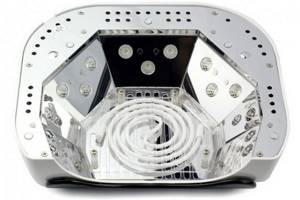
Lamp – hybrid
The operating principle of the lamps is different, but they all have the goal of polymerizing the gel. How long to keep your nails in each of them depends on its type.
Answers on questions:
Why did the UV lamp stop drying the gel?
Try changing the fluorescent lamps inside the device; they lose their power over time. Also, wipe the inner chamber of the tunnel. Reflectors (reflective surfaces) must always be clean, otherwise they will not reflect enough ultraviolet light.
How do you know when it's time to change fluorescent lamps?
Try to dry the finishing gel without a sticky layer on the tips; if it takes a long time to dry or does not dry at all, it’s time to change the lamps. Another sign is that if the lamp at the base has darkened, it is also better to change it.
The main types of lamps for drying gel polishes and their advantages and disadvantages
So what kind of lamp do you need? For each nail service technician, all indicators vary. To some, “the best” will seem like a past stage that it’s time to improve.
- Price. Beginners choose cheap options that do not shine with technical aspects, but at the same time perform the main task - drying the nail coating material.
- Power. The higher this indicator, the less time the client will spend at the lamp. How many watts should the device have? For beginners, 18 watts (if we talk about UV lamps) or 9 watts (if we talk about LED lamps) are suitable, but how much to dry depends on the coating - base, top, gel polish, finish, etc.
- Ease of use. Touch (turns on when you place your hand inside the lamp, often with a timer), mechanical (has a switch, not all have a timer). Additional conveniences - power modes, time indicator.
- Capacity. One hand, two or just a separate finger - this choice is provided by modern manufacturers of lamps for drying nail coatings. The drying chamber should also be comfortable. It’s worth checking this when choosing in a store or just believing the description on the online store page.
- Versatility of use. There are narrow-profile specialists who deal purely with extensions/coating, and there are also “generalists”. For each case, a lamp of a certain type or a more general use may be suitable.
There is no best lamp for all craftsmen; everyone chooses according to their own requirements. The difference is the speed at which the gel dries.
It is impossible to overdry the gel (and this is what beginners are so afraid of), this applies to any of the lamps - after polymerization is completed, it will remain unchanged on the nail.
Ultraviolet lamps with fluorescent bulbs (UV)
These lamps were the pioneers. It was possible to grow nails with gel or acrylic only with such a lamp. On the inner walls of the light bulb there is a phosphor - a substance that conducts UV rays.

- Price. Such lamps for drying and hardening gel polish are relatively cheap, which is why they deserve their popularity.
- Power. It can be different - from 9 W to 54 W. Ratings less than 9 W are not popular, although they still exist.
- Control type. There are different types of devices – both touch-sensitive and manually controlled. How many minutes to keep? Depending on the quality of the coating material. The time can vary from half a minute to several minutes.
- Capacity. This indicator is varied. You can dry one hand, two at once, or each finger separately.
- Versatility of use. Suitable for drying almost all materials that require polymerization.
- Pros. Low cost, good choice of design and additional characteristics, wide range of uses (except for gels, where you can find the LED inscription).
- Minuses. The closer the day for replacing the lamps, the more problems can be noticed during drying: the gel curls and bubbles. Any coating can also wrinkle and shrink.
LED lamps
LED lamps have become an absolute breakthrough. The principle of their operation differs from ultraviolet. The radiation comes from LED semiconductors, which form a stream of light with ultraviolet radiation. Like all drying devices, it has its positive and negative sides.
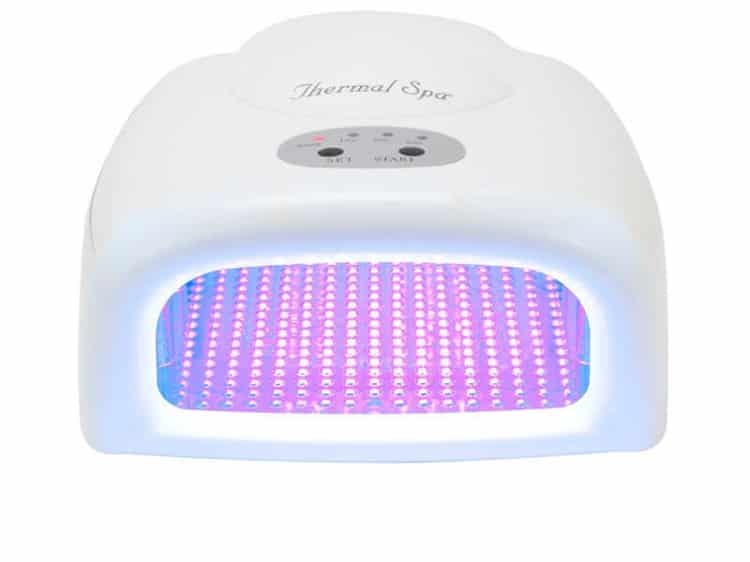
- Price. Many times higher than that of UV lamps. But comparing its purchase cost + maintenance, the LED option is more profitable. Having once invested a certain amount in the unit, it will last up to 100 thousand hours without replacing elements.
- Power. Even the lowest indicator lamp for drying and hardening (polymerization) of gel polish can complete it in a few seconds. Speed of impact is the main advantage for any master.
- Control type. Lamps differ in control - mechanical, touch, size (from pocket versions to home stationary ones). All of them are easy to use, but the gradation of cost comes precisely because of these indicators. The weight is light, lower than that of UV devices.
- Capacity. Pocket options can accommodate one finger or several. For ultra-efficient artists who are able to quickly cover their nails, there are lamps for drying both hands at the same time.
- Versatility of use. LED lamps cannot work with absolutely all materials, as they have a poor range of UV waves. Modern coatings can interact with LED radiation, but not all. If, for example, a bottle of shellac is marked LED, then it will be suitable for such a lamp.
- Pros. Gel drying in a matter of seconds. After purchase it does not require additional capital investment.
- Minuses. High initial cost and small beam range, which prevents the use of gel for extensions.
Cold cathode lamps (CCFL devices)
Gas-filled tubes can be seen on the signs of clubs and shopping centers. But the fact that cold cathode fluorescent lamps will become drying gel coatings has only recently become known.

- Price. Lamps of the ccfl type (Cold Cathode Fluorescent Lamp) are rarely found in their “pure” form; the lion’s share of devices on the market are hybrids that combine the radiation of fluorescent lamps and LEDs. Prices remain at the same level as those indicated for LED units.
- Power. CCFL devices are distinguished by high performance, the average value is 24 watts, and when combined with led, it increases - about 48 watts. But there is more.
- Control type. As with all modern devices, there is a choice when it comes to control - you can do it manually or use a sensor and timer.
- Capacity. They often have a standard capacity - for one hand.
- Versatility of use. Most gel polishes are cured under ultraviolet light from CCFL devices, as they have a wide spectrum of radiation. Particularly effective when combined with led options.
- Pros. Long service life - up to 80 thousand hours. Interacts with many gels.
- Minuses. Gels that have the LED mark on the package cannot be polymerized in this lamp.
Hybrids
They combine two radiation sources - CCFL and LED. In order for the extended nails to dry as efficiently as possible, a choice is made towards hybrid devices.
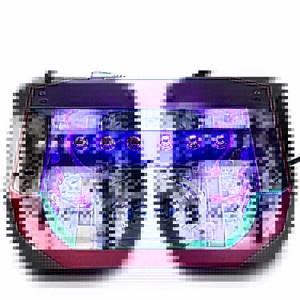
- Price. Expensive lamps that differ not only in price, but in ease of use.
- Power. The indicator is about 48 watts. Professional models reach 66 watts.
- Control type. “Advanced” models are equipped with timers, where you can select the required time for the gel to dry.
- Capacity. The models released do not differ much in variety; these are chambers for drying one hand.
- Versatility of use. A truly universal option, which is suitable for making a high-quality manicure, regardless of the type of gel.
- Pros. Durability and versatility are the main advantages.
- Minuses. High cost, which will be justified during operation.
Coating composition
Of course, each gel polish manufacturer has its own secret ingredients that make the product exclusive, but the basic composition of the coating is always the same. It includes the following components:
- film former - a substance that is susceptible to UV radiation;
- photoinitiator;
- active diluents;
- pigments;
- additives (they are responsible for the additional properties of the coating and maintaining gloss).
A good gel polish can last on your nails for quite a long time.
Features of operation
Each type of lamp that is capable of emitting ultraviolet rays has its own characteristics. Because of this, ease of use can be both more comfortable and painful.
UV lamp
Powered by network. By plugging it into the outlet and pressing the switch, you will notice a slight blinking - these are induction lamps. They last longer, withstand power failures without consequences, but are not convenient to carry - they are quite heavy. Many lamps have a fuse - during voltage surges, it will protect the unit from combustion.
Electronic type - the lamp lights up at full power immediately. Any of these types does not have much difference in service life - up to 3 months. Next, you need to upgrade the dryer - change the lamps. Each time you turn the device on/off only reduces its service life.

Since the dryer can overheat, using it during the hot season can cause a lot of inconvenience. The fan, which is often built into such units, practically does not help. Often the coating material burns the nail plate - here it’s not the lamp, but the material.
LED lamp
There is no tendency to overheat, even during long-term operation. After a pair of diodes burn out, functionality does not decrease. The applied gel does not shrink or wrinkle even if the device is partially malfunctioning. The number of times the lamp is turned on/off does not affect the “life” of such a stove.
How many watts does a lamp need to dry the gel quickly? For home use, it is enough to take a 9-watt lamp; for professionals, a higher one. Such an oven for baking gel polish is not harmful, does not have extraneous radiation, and is not capable of damaging the manicure due to its incorrect operation.
When turned on, it does not emit heat; the LED lamp is convenient for drying gels even in hot weather.
Cold cathode lamps and hybrids
During long-term operation, such a lamp has no chance to heat up, and energy consumption is minimal.
Hybrids also consume a small amount of energy; the number of starts is not taken into account - only the total temporary resource. The weight of such a lamp ranges from 2 kg.
How to choose a lamp for drying gel polishes: a review of manufacturers
What kind of lamp should be so that when using it you can experience only pleasure? Not only are the characteristics of each specimen different, but the companies are also incomprehensible.
Manicure lamps must meet the requirements: design, power, weight, price, additional features. By combining these qualities, you can get the optimal device for the job. The shape can be round, rectangular, square.
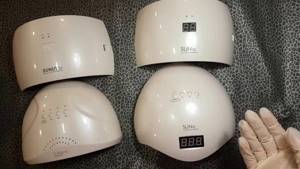
The following brands are popular in the nail industry market that offer drying lamps: polaris, planet nails, gelish, sunuv, sunone, beauty nail lamp, runail, irisk, professional nail, jessnail, valori, san. They produce lamps of different types with different technical data. Here are the most popular ones.
| UV | LED | CCFL | hybrid | |
| Resource, hours | up to 10 thousand | up to 100 thousand | up to 80 thousand | up to 80 thousand |
| Service | Lamps need to be replaced every 3 months. (with regular use) | — | — | — |
| Power (optimal indicator), W | 36-54 | 9-12 | 12-18 | 24-36(48) |
| Polymerization time (for example, gel polish) | up to 3 min. | up to 1 min. | up to 3 min. | up to 1 min. |
| Material with which it acts | everything except with the LED icon on the bottle | Gels marked LED on the bottle | everything except with the LED icon on the bottle | Any material for polymerization |
Lamps from leading companies interact well with equally popular gels that are at the top of the rating - Cody, toffee, quick gel, Amy, harmony, posh, crystal, diamond, cnd, opi, bluesky, Vivienne sabot, dnl, heart, dryer. Such gels are called popular not only because they look impressive and are accessible to any master, but also because of their quality (easy to apply, no need to paint in many layers to get a rich color, they can be decorated with additional accessories, etc.) .d.).
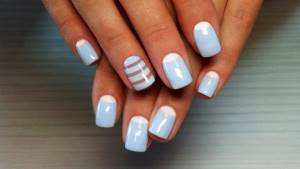
High-quality coating result
Most manufacturers have their own line of manicure tools (including lamps), as well as consumables - biogels, shellacs or simply gels for extensions. These are tnl, irisk, kodi, essie, which provide craftsmen with all the necessary tools for work.
The description on the box of a new lamp cannot always give a complete picture of the device. Why are some buttons needed, is there a guarantee, can this lamp be repaired (there are disposable options that, after failure, cannot be repaired).
It is easier for the manufacturer to abdicate responsibility than to repair it. Here is a mini-rating of those brands that nail technicians love (they have won trust due to their service life and ease of repair):
- Runail;
- Irisk;
- Sunuv;
- Gelish;
- Polaris.
Having decided on the technical characteristics and the company, you can safely start making your choice. There are also life hacks for drying gel at home, without a manicure lamp. Take an ordinary lamp, screw in an LED or UV lamp, and thus create a coating with drying. But a homemade system is often unable to provide the expected result.
But, in addition to the fact that your nails need to be painted (extended), you will need to get a manicure. For the hardware you will need a machine - a milling machine.
The necessary goods can be found on alkh in both new and used condition. When buying a used item, you need to remember that the lamp for drying gel polish may already be close to the end of its life and fail immediately after purchase.


